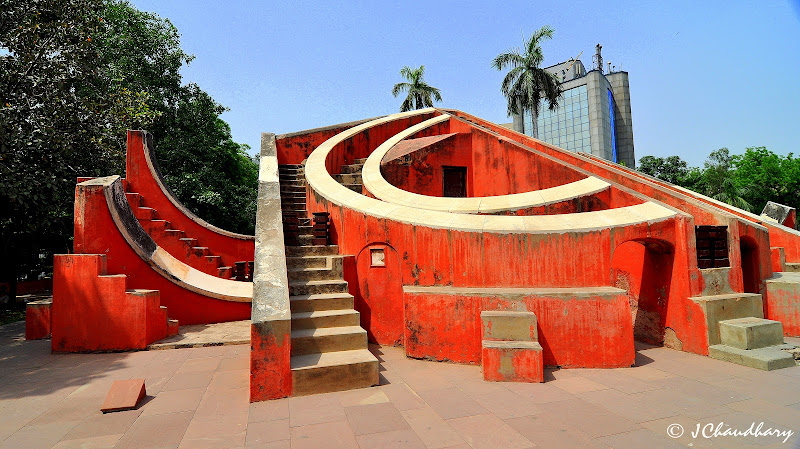
About Jantar Mantar
Description
If you ever find yourself wandering through the bustling heart of New Delhi, the Jantar Mantar quietly stands its ground as a testament to human curiosity and a pretty mind-blowing piece of history. Built way back in 1724 by Maharaja Jai Singh II (not a Mughal this time, bit of a common mix-up!), this astronomical observatory isn’t just some dusty old monument. It’s 13 massive instruments designed with such precision that they allowed people centuries ago to measure time, predict eclipses, and track celestial bodies with surprising accuracy. I’m always amazed at how folks back then managed this without any electronics—just stone, math, and a whole lot of brainpower.
And when you walk among the towering geometric shapes—it’s almost like stepping into a giant mechanical clock. Each instrument serves its own purpose: from the big sundial that still tells fairly accurate time, to the Jaipur quadrant, smartly crafted for finding star positions. You get this buzz of both scientific genius and architectural beauty at once. Sure, the place isn’t perfect and can feel a bit run-down in spots, but that adds character, don’t you think? It’s like touching history, kind of raw, brash, and real.
Unlike many tourist spots that plaster their walls with info, Jantar Mantar invites you to figure things out yourself—or bring a guide who knows their astronomy stuff. Kids especially seem to enjoy seeing those huge shapes and running around, imagining some ancient alien tech or a giant’s playground (trust me, I’ve seen that happen). And don’t worry if you’re not an astronomy whiz; the experience is more about marveling at human innovation and that old-world obsession with stars than getting lost in complex equations.
Key Features
- Thirteen monumental stone and marble instruments engineered for astronomical measurements.
- Samrat Yantra: The world’s largest sundial, with an astonishing accuracy of about 2 seconds.
- Jaipur Yantra and Rama Yantra: Instruments designed for measuring celestial altitudes and azimuths.
- Accessible design, including wheelchair-friendly entrances and parking areas, making it welcoming for all visitors.
- Free parking alongside paid options for hassle-free visits.
- Kid-friendly environment and educational value without feeling like a lecture.
- Functional architecture that doubles as open-air scientific equipment you can touch and explore.
- Located close to major hubs like Connaught Place, making it easy to drop in while exploring Delhi’s center.
Best Time to Visit
The best time to check out Jantar Mantar really depends on your weather tolerance. Delhi can get scorching in the summer—think 45°C or more—which is killer when you’re walking around an open-air observatory with no shade. So definitely spring and autumn (October to March) are prime. The weather’s cool, you avoid sweat puddles on your shoes, and the air isn’t too hazy, which means your stargazing—or just star-gazing-pretending—is more vivid.
Early mornings are another hidden gem for visiting, believe it or not. You get the soft touch of the sunrise painting those stone instruments with warm golden light, and it’s much less crowded. Also, the sundial does its magic best in the bright daylight, so timing your visit before noon can add to the experience.
How to Get There
Jantar Mantar is pretty much smack in the middle of New Delhi’s whirlwind, so getting there is honestly not a nightmare if you plan a bit. If you’re coming by metro, take the Yellow Line to Patel Chowk Station or the Rajiv Chowk Station—both are within walking distance, giving you a nice stroll through some classic Delhi streets. You might want to keep an eye on your belongings during the walk, though. Delhi’s crowd can be an acquired taste—think energetic, sometimes loud, but mostly friendly once you get the rhythm.
If you’re traveling by car or taxi, there’s free parking nearby, which is a rare treat in this part of the city. But, fair warning, traffic can get snarled, especially during rush hours, so patience is a virtue here. And well, sometimes just hopping on an auto-rickshaw adds that spicy local flavor to your adventure—hold on tight!
Tips for Visiting
Alright, if you want to squeeze the most out of your visit to Jantar Mantar, here are a few friendly pointers, based on my own and others’ mildly chaotic but fun experiences:
- Hire a guide or download an audio tour. The instruments can look intimidating without context, but a good explainer will light up the whole place for you, no jargon needed.
- Go early to beat the crowd and the heat. Especially in the cooler months, an early visit means you’ll have more space to roam and better photo ops too.
- Wear comfortable shoes. You’ll be walking on marble and stone surfaces that can get slippery in the monsoons, so grip is king.
- Bring water and a hat. Shade is limited and the Delhi sun does not mess around.
- Keep kids engaged with some pre-visit stories. Tell them about how people used these giant stones like calculators for the sky—it might just spark some mini-astronomers!
- Check for any maintenance or renovation works. Sometimes parts of the observatory close for upkeep. It’s always best to confirm before you show up starving for stardust.
- Respect the site. These instruments aren’t just cool shapes—they’re centuries-old, so try not to climb or bounce around too much.
- Combine with nearby attractions like India Gate, Rashtrapati Bhavan, or Connaught Place for a solid day out.
Oh, and here’s a little personal secret—sit on one of the steps near the Samrat Yantra at sunset, watch the shadow move slowly across the dial, and reflect on how folks back in the 1700s looked up at the same sky, figuring out the universe one stone at a time. There’s something humbling and oddly inspiring about that.